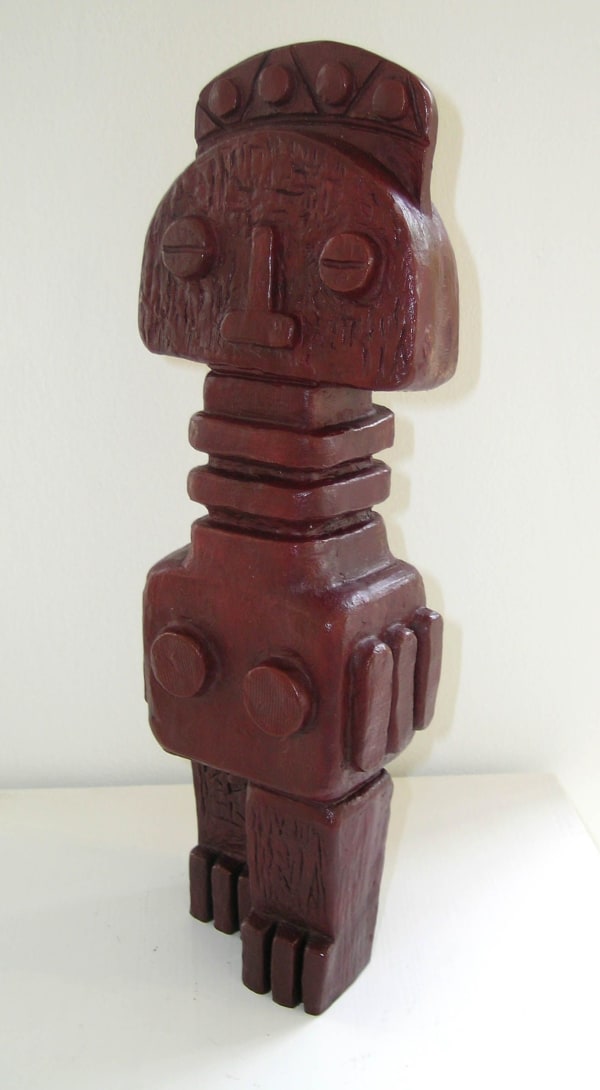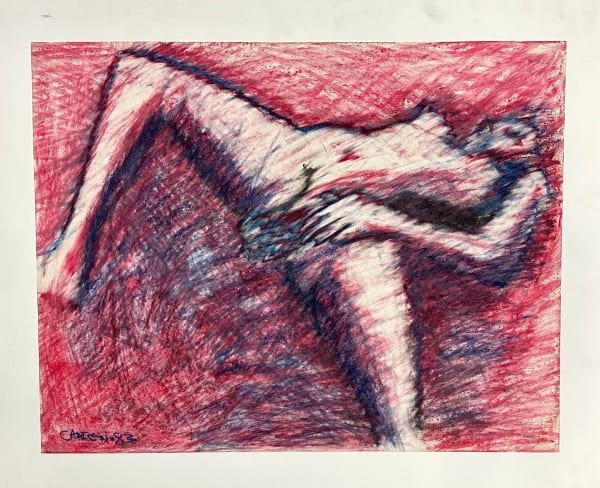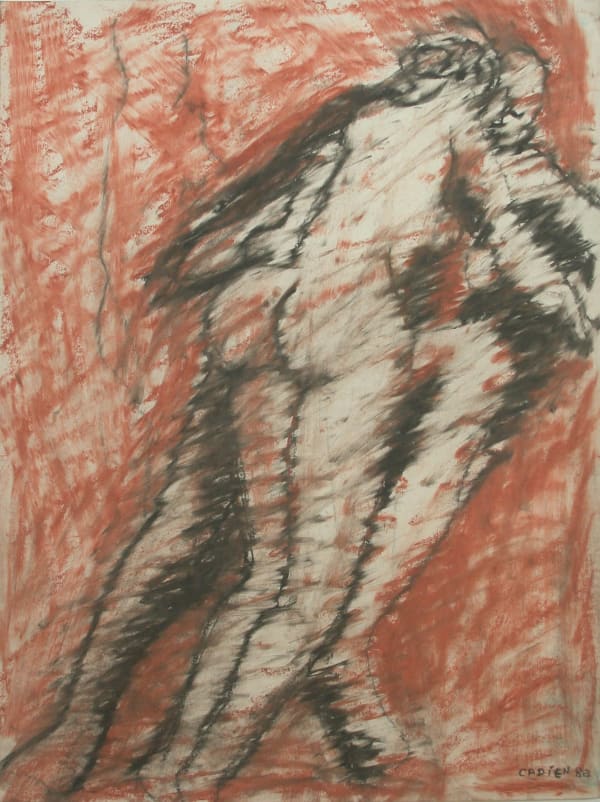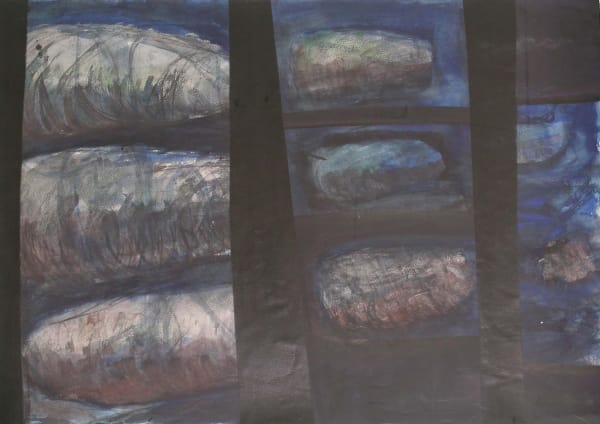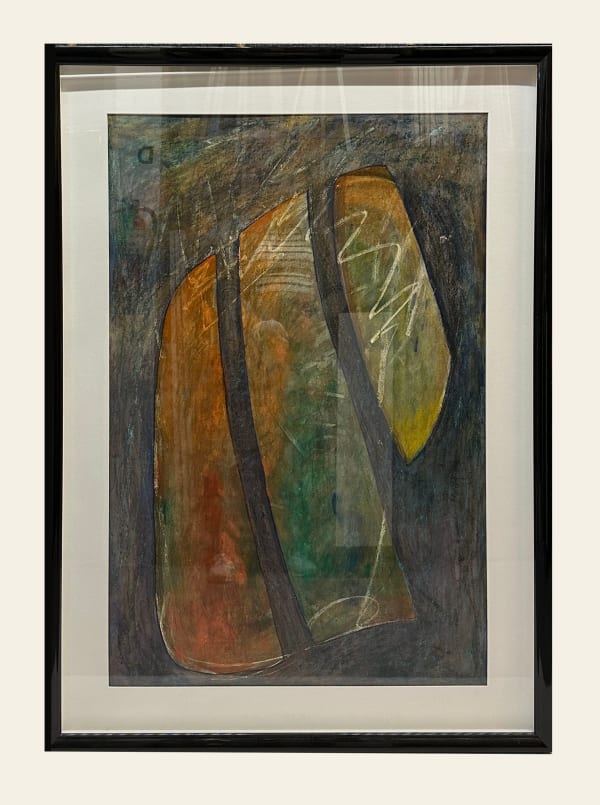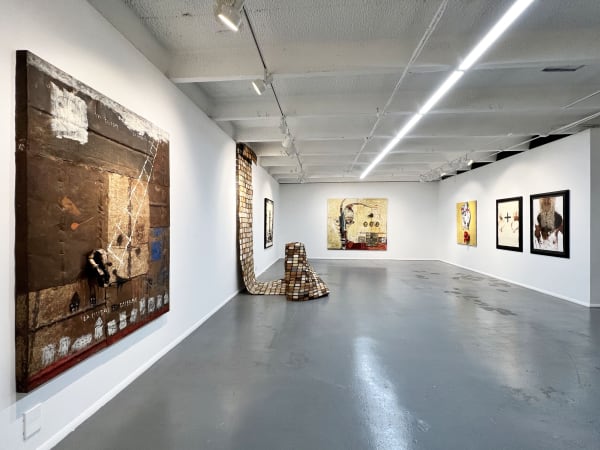He fostered their interest in abstraction and combined it with iconography then current in Rastafarian circles. The result was imagery that paid homage to European modern art but was more deeply rooted in black nationalism.
He was initially trained as a sculptor but after returning from post-graduate studies in Canada he began to create paintings that with bold colour, clearly defined forms and self-conscious use of spatial relationships. He brought a fresh approach to Jamaican composition.Cadien’s work was informed by expressionist artists of a slightly older generation like Karl Parboosingh and Eugene Hyde and Kofi Kayiga.
-
 Eric CadienUntitled, 1993Bronze Sculpture18 x 6 x 4 inSoldView more details
Eric CadienUntitled, 1993Bronze Sculpture18 x 6 x 4 inSoldView more details -
 Eric CadienUntitled, 1993Bronze Sculpture17 x 6 x 6 inSoldView more details
Eric CadienUntitled, 1993Bronze Sculpture17 x 6 x 6 inSoldView more details -
Eric CadienKids on Bicycle, 1991Acrylic on Canvas20 x 24 in
50.8 x 60.96 cmView more details -
Eric CadienKing Mask, 1991Acrylic on Canvas20 x 16 in
50.8 x 40.64 cmView more details -
Eric CadienMusician Scenes, 1991Acrylic on Canvas28 x 22 in
71.12 x 55.88 cmView more details -
Eric CadienSleeping Figure in Chair, 1991Acrylic on Canvas12 x 18 in
30.48 x 45.72 cmView more details -
Eric CadienThe Wait, 1991Acrylic on Canvas16 x 20 in
40.64 x 50.8 cmView more details -
Eric CadienTwo Figures in Composition, 1991Acrylic on Canvas16 x 20 in
40.64 x 50.8 cmView more details -
 Eric CadienThe Kiss, 1988Acrylic on Canvas51 x 36 in
Eric CadienThe Kiss, 1988Acrylic on Canvas51 x 36 in
129.54 x 91.44 cmView more details -
 Eric CadienRed & White Figures, 1987Acrylic on Paper26 x 20 inSold
Eric CadienRed & White Figures, 1987Acrylic on Paper26 x 20 inSold
66.04 x 50.8 cmView more details -
 Eric CadienRed Reclining Figures, 1987Acrylic on Paper26 x 20 in$ 2,000.00
Eric CadienRed Reclining Figures, 1987Acrylic on Paper26 x 20 in$ 2,000.00
66.04 x 50.8 cmView more details -
Eric CadienThree Kings, 1987Acrylic on Canvas48 x 40 inSold
121.92 x 101.6 cmView more details -
 Eric CadienFigures in Composition, 1986Acrylic on Paper26 x 20 in$ 750.00 Sold
Eric CadienFigures in Composition, 1986Acrylic on Paper26 x 20 in$ 750.00 Sold
66.04 x 50.8 cmView more details -
 Eric CadienFigures in Composition, 1986Acrylic on Paper28 1/2 x 21 1/2 in
Eric CadienFigures in Composition, 1986Acrylic on Paper28 1/2 x 21 1/2 in
72.4 x 54.6 cmView more details -
 Eric CadienReclining Woman, 1986Acrylic on Paper16.50 x 14 inSold
Eric CadienReclining Woman, 1986Acrylic on Paper16.50 x 14 inSold
41.91 x 35.56 cmView more details -
 Eric CadienFoggy Female Nude, 1983Pastel on paper20 x 26 in
Eric CadienFoggy Female Nude, 1983Pastel on paper20 x 26 in
50.8 x 66.04 cmView more details -
 Eric CadienFoggy Male Nude, 1983Pastel on paper26 x 20 in
Eric CadienFoggy Male Nude, 1983Pastel on paper26 x 20 in
66.04 x 50.8 cmView more details -
 Eric CadienSeated man with woman , 1983Gouache on paper26 x 20 in
Eric CadienSeated man with woman , 1983Gouache on paper26 x 20 in
66.04 x 50.8 cmView more details -
 Eric CadienStanding couple (1983), 1983Gouache on paper15 x 11 in
Eric CadienStanding couple (1983), 1983Gouache on paper15 x 11 in
38.1 x 27.94 cmView more details -
 Eric CadienStanding Figures, 1983Pastel on paper26 x 20 in
Eric CadienStanding Figures, 1983Pastel on paper26 x 20 in
66.04 x 50.8 cmView more details -
 Eric CadienFigure and Head in Composition, 1982Pastel on paper15 x 22 in
Eric CadienFigure and Head in Composition, 1982Pastel on paper15 x 22 in
38.1 x 55.88 cmView more details -
 Eric CadienFoggy Couple (1982), 1982Pastel on paper26 x 20 in
Eric CadienFoggy Couple (1982), 1982Pastel on paper26 x 20 in
66.04 x 50.8 cmView more details -
 Eric CadienFragmented Standing Couple, 1982Gouache on paper26 x 20 in
Eric CadienFragmented Standing Couple, 1982Gouache on paper26 x 20 in
66.04 x 50.8 cmView more details -
 Eric CadienStanding Group, 1982Gouache on paper20 x 25 in
Eric CadienStanding Group, 1982Gouache on paper20 x 25 in
50.8 x 63.5 cmView more details -
 Eric CadienAztec Figure 1980, 1980Acrylic on Paper22 x 15 in
Eric CadienAztec Figure 1980, 1980Acrylic on Paper22 x 15 in
55.88 x 38.1 cmView more details -
 Eric CadienReclining Segmented Figure, 1980Watercolor on paper21 1/2 x 28 1/2 in
Eric CadienReclining Segmented Figure, 1980Watercolor on paper21 1/2 x 28 1/2 in
54.6 x 72.4 cmView more details -
 Eric CadienSegmented Figure (1980), 1980Acrylic on Paper22 x 28.50 in
Eric CadienSegmented Figure (1980), 1980Acrylic on Paper22 x 28.50 in
55.88 x 72.39 cmView more details -
 Eric CadienSegmented Figures, 1980Acrylic on Paper20.50 x 26 in
Eric CadienSegmented Figures, 1980Acrylic on Paper20.50 x 26 in
52.07 x 66.04 cm
Estimate: $900 - $1,200View more details -
 Eric CadienThree figures (1980), 1980Gouache on paper26 x 20 in
Eric CadienThree figures (1980), 1980Gouache on paper26 x 20 in
66.04 x 50.8 cmView more details -
 Eric CadienSegmented Figures, 1979Acrylic on Paper26 x 20 in
Eric CadienSegmented Figures, 1979Acrylic on Paper26 x 20 in
66.04 x 50.8 cmView more details -
 Eric CadienFragmented Space, 1977Gouache on paper18.50 x 26 in
Eric CadienFragmented Space, 1977Gouache on paper18.50 x 26 in
46.99 x 66.04 cmView more details -
 Eric CadienShapes in Space II, 1977Mixed media on Paper42 x 28 in
Eric CadienShapes in Space II, 1977Mixed media on Paper42 x 28 in
106.68 x 71.12 cmView more details -
Eric CadienFigures with bicycle, 1975gouache on paper17.25 x 11.75 inSold
43.81 x 29.84 cmView more details -
 Eric CadienSegmented Figure, 1975Gouache on paper17.25 x 11.75 in
Eric CadienSegmented Figure, 1975Gouache on paper17.25 x 11.75 in
43.81 x 29.84 cmView more details -
Eric Cadien"Cyclist and Friend" 1991Acrylic on Canvas30 x 24 in
76.2 x 60.96 cmView more details -
Eric Cadien4 Figures in Blue BackgroundAcrylic on Canvas22 x 28 in
55.88 x 71.12 cmView more details -
Eric CadienShapes in Space #2Acrylic on Paper42 x 28 in
106.68 x 71.12 cmView more details -
 Eric CadienThree Standing Figures (1983)watercolor on paper26 x 20 in
Eric CadienThree Standing Figures (1983)watercolor on paper26 x 20 in
66.04 x 50.8 cmView more details -
Eric CadienYouthwatercolor on paper20 x 16 in
50.8 x 40.64 cmView more details
Cadien was too young to completely identify with the concerns of Jamaica’s earliest abstract painters, neither was he a part of that later group of Expressionist painters of the eighties labelled ‘new imagists’.
Born Trelawny, Jamaica – Died Kingston, Jamaica
Eric Cadien attended the ‘art school’ during the dynamic seventies when self- reliance and self-determination became the political watch-words that guided Jamaica beyond independence towards self-government and Democratic Socialism. At the Jamaica School of Art Jerry Craig and Hope Brooks taught him, but his earliest influences in terms of style and technical development came from artists such as Winston Patrick and Osmond Watson and Kofi Kayiga.
In the last years of his life he reveled in the 2D surface, his work became more representational and the figure as nude, musician, kings and queens, created a pantheon of images rooted African and Jamaican symbolism. His work would set a precedent for those students he later tutored in experimental painting and sculpture at the Jamaica School of Art such as Omari Ra/Robert Cookhorne, Kalfani Ra/Douglas Wallace, and Stanford Watson. Cadien was too young to completely identify with the concerns of Jamaica’s earliest abstract painters, neither was he a part of that later group of Expressionist painters of the eighties labelled ‘new imagists’. The arrested development of his oeuvre due to his untimely death has allowed others to view him as an artist who bridged the two movements in the development Jamaica’s modern art. But, Cadien’s own thoughts about creativity and his paintings exhibited just prior to his death suggest that his work was still in transition and not limited to any school or style. He wrote: ‘A consistent artist is a thoughtless one, because he conforms to a style; he repeats himself and thinks in a groove. The artist must always try to understand himself, and understanding cannot come through conformity, but through self -knowledge which is always new.’


